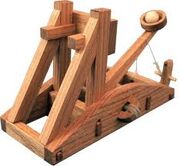
The Torsion Catapult is a siege weapon from the Middle Ages. It was the long-range weapon of William the Conqueror. Horses were normally used to pull the catapult back, giving it more tension than a crank powered or human powered catapult.
Stats
- Weight: 700 lbs
- Ordnance: Wood, stone, flammable oil pots or fireballs, and diseased corpses
- Range: 100-150 yards
- Average reload time: 1:01 (user dependent)
- Fastest reload time: 52 seconds
- Velocity: 36 mph
- Introduced: 900 BC
- 600 ft of rope
- Horse or Winch operated
History
Macedonian Ballistas and Oxybelles were the first European siege weapons. Functioning like a giant crossbow: they would fire stones or giant arrow bolts at high velocities.
Polyidus of Thessaly introduced the concept of a Torsion Ballista and Torsion Oxybelles, replacing the crank power used in the crossbows inspired by the Gastraphetes.
The first use of the Torsion Catapult was with the Onager: first mentioned in 353 AD to be used by the Roman Empire. The largescale Medieval Torsion Catapult was called a Mangonel.
Catapults, unlike Ballistas, could lob their projectiles to strike at the relatively more vulnerable rooftops or to strike at soldiers directly by dodging the wall entirely. Catapults also could exert more force than a Ballista: as the Ballista used a large string like a normal sized crossbow.
The catapult was still used throughout the Medieval Ages but was overshadowed by the larger Trebuchet. The Trebuchet uses a long swing arm instead of rope torsion to fling the projectile, allowing longer range and stronger impact. While existing since the 4th century BC: the Medieval Counterweight Trebuchet was introduced to Europe in the late 1100s AD. [1]
Catapults and Trebuchets were eventually replaced by the Siege Cannon: which was more portable, has longer range and could fire cannonballs with more force than what catapults could output. One of the last incidences of catapults used in warfare was by Hernán Cortés at the Fall of Tenochtitlan in 1521: and this was primarily due to the fact that Cortes did not have enough gunpowder to use his cannons.
Catapults have still been used in modern times by guerrilla fighters, rebels and rioters: primarily to fling explosives or Molotov Cocktails. However catapult use by conventional modern armies is rare.
Test
The Torsion Catapult went up against Joan of Arc's Siege Cannon. On the field, the catapult was set to hit targets at 50 yards. The objective was to launch projectiles over the wall and strike as many targets as possible. This included guards along the ramparts, and villagers in the "castle courtyard". The crew used four stones and a pig's head, representing Norman soldiers using dead animals to spread the bubonic plague.
The first shot cleared the wall but didn't hit any targets. The second shot used a pig head to spread the plague. The next three rocks hit three targets, one in the village, one in a house and one guard on the rampart (in the head).
While the Catapult could reload faster, the cannon did more damage and the loudness of the blast caused a psychological impact, so the edge went to the cannon.
Trivia
- Roman catapults could use hair as a substitute for rope. Roman women could donate their hair to support the construction of catapults.
- The War Wolf was the largest trebuchet in history: created by Edward I in 1304 during the Scottish War of Independence Siege of Stirling Castle. It could fling 300 pound boulders.